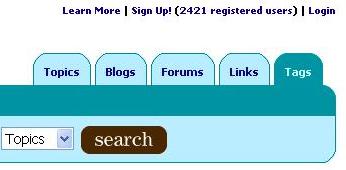Have you heard of tagging? Not the type of tagging where cans of spray paint are used to create letters, symbols, and pictures on public walls and fences. I am talking about tagging on the Internet using Web sites that have tagging features included. You may have noticed on the Families.com homepage one of the four tabs at the top of page is entitled, “Tags.” It looks something like this:
Have you ever clicked on the “Tags” tab? If so, you may have discovered the Families.com tag page, but been at a loss as to what this page is about and what tags are for? You’re not alone. A number of people have asked about tagging, including the purpose and how to do it. To help answer your questions and put your fears to rest, I will present a series of blogs devoted to tagging on Families.com. These blogs will include an overview of tagging, answers to some frequently asked questions, and a brief how-to lesson about using tags on Families.com. I have divided these topics into smaller blogs to for the sake of readability. After reading these blogs, I hope you’ll feel more informed about tags and you’ll try out tagging on Families.com.
What are tags?
Tags are descriptive terms, or keywords, used to describe some type of electronic content. Users like you can attach tags to online items such as articles, blogs, and photos as a way of describing the items. The tags can then be used by you and others as a way or organizing for later quick and easy access. In this way you don’t need to rely on someone else to organize content for you and you don’t need to scroll through lists of articles to find one or two on your topic of interest. Online tagging has become popular among sites that focus on a variety of different topics such as blogging, personal photo albums, and Web bookmarks.
Think of tags like Internet bookmarks. When you find a site you want to visit later, you bookmark it. The Web site reference is stored on your computer so with the click of your mouse, you can revisit the site without having to remember the actual Web address. Tags work in a similar way, but rather than bookmarking a whole Web site, you bookmark a part of the site with terms that you type in. In this way, the terms you type in, or tags, are relevant to you and how you describe what you’re tagging, not how someone else would describe it.
For example, say you are searching Familes.com for information about video games. First, you will probably bookmark Families.com in your Internet browser so you can come back to the site later. Each time you come back to the site, however, you will have to search again for articles and blogs on video games. Instead of searching again, you could have tagged articles and blogs you found about video games. You could also check and see if other people have used tags to describe articles and blogs about video games. In this way, you can have easier and quicker access to information you are looking for.
Tomorrow’s blog
Check out tomorrow’s blog to learn more about the uses of tags including who can tag and how long tags should be.


